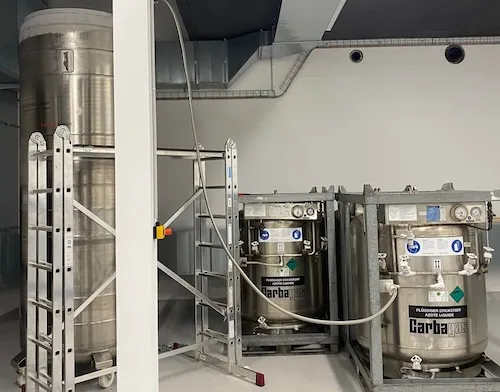Cryogenics: Following in the footsteps of the United States and China, it is now possible in Europe to cryoconserve the body after death in the hope of returning to life in the future. However, there is no precise or even probable date for this, as it will depend on the development of scientific research. For the time being, therefore, it is a kind of gamble that depends on the trust placed in science and technology.
However, some are optimistic about the future, such as 38-year-old doctor Emil Kendziorra, who, having spent his career searching for solutions to cancer, has decided to devote himself to an equally complex challenge with a very long-term perspective. In 2019, he launched Tomorrow Biostasis, Europe’s first company dedicated to putting people’s bodies and brains into hibernation. ‘It may take 100, 300, 500 years before it is possible to revive, heal and rejuvenate a human organism. It is a risk, but it is also an opportunity,’ says Kendziorra.
Bodies preserved at almost -200 degrees
Of course, this is a question that does not concern the masses at the moment because the cost of access to the programme greatly limits the circle of those who are interested. It should also be borne in mind that cryogenics offers hope to those who have lived with disabilities and serious physical problems. Not surprisingly, those most interested are people in the 25-45 age group. There are currently four clients who have chosen Tomorrow Biostasis, which is based in Berlin but stores bodies for preservation elsewhere.
The deceased are brought to Rafz, a small village of 4,000 people in the Swiss canton of Zurich, close to the German border, which was chosen after a lengthy search because it has a near-zero crime rate, is not prone to flooding and is not an earthquake zone.
The deceased are kept in 3.20 metre-high steel cells filled with around 1,900 litres of liquid nitrogen at a temperature of -196 degrees Celsius. Before they reach their destination, a detailed process must be followed to prevent the cells from decomposing. After the client signs up for Kendziorra’s initial treatment, the person is taken over as soon as they are declared dead, ‘when the only alternatives are burial or cremation,’ the doctor told Bild.




Cryogenics
The process of cooling the body begins inside the ambulance, which has been converted from the original, with the instruments and technology needed for the operation. The first step is cardiac massage and oxygen administration via a breathing mask. ‘The aim is not to reanimate the deceased but to slow down and stop the cell death that has already begun. When the heart stops beating, the cells are deprived of oxygen and begin to decompose,’ the doctor said.
During the journey to Rafz, the body is cooled by about 1 degree per minute to -76 degrees, with some of the water inside replaced by a preservative solution. The manoeuvres on the clients only concern the medical area, Kendziorra added, clarifying that make-up and hair remain intact. In the absence of scientific knowledge, there is no time limit on customer care. ‘There will always be staff on site to ensure safety and the supply of liquid nitrogen,’ says the founder of Tomorrow Biostasis.
In order to secure the necessary resources for a job that could potentially last hundreds of years, the start-up has set a monthly subscription of 20 euros per month for those who opt for whole-body hibernation and 6 euros for those who only want to preserve the brain.
Costs and uncertainties
However, the price is a deterrent for those who want to cryo-preserve their body and brain: 200,000 euros, reduced to 75,000 euros for the brain. To be paid before death, of course. In addition to the four current clients, Tomorrow Biostasis has a waiting list of 400, but Kendziorra’s idea is to reduce the cost to 30,000 over the next few years in order to increase the number of clients. ‘We don’t know if it will work, but it’s an opportunity we can seize in our lifetime,’ says the doctor.
His gamble also depends on overcoming the organ risks associated with the vitrification process since filling the brain with antifreeze could cause irreparable damage. There is no certainty on this point either, and it is to be hoped that science will be able to clarify this and many other doubts in the future.



